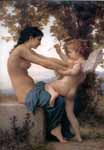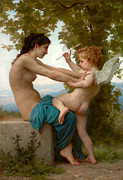J. Paul Getty Museum

Portrait of John Talbot, later 1st Earl Talbot, Pompeo Batoni

View in the Ile-de-France, Jean-Victor Bertin

Entrance to the Jardin Turc, Louis-Léopold Boilly

The Salt Marshes near Trouville, Richard Parkes Bonington

Flower Still Life, Ambrosius Bosschaert the Elder
A Young Girl Defending Herself Against Eros, William-Adolphe Bouguereau

Christ and the Adulteress, Valentin de Boulogne

David with His Sword, Salomon de Bray
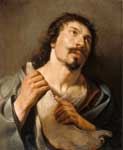
Samson with the Jawbone, Salomon de Bray

Shipping in a Calm at Flushing with a States General Yacht Firing a Salute, Jan van de Cappelle
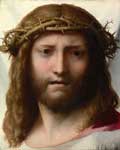
Head of Christ, Correggio
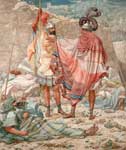
Mercy. David Spareth Saul's Life, Richard Dadd
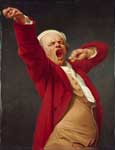
Self-Portrait, Yawning, Joseph Ducreux

View of the Residence of Archduke Johann in Gastein Hot Springs, Thomas Ender

Fridolin Assists with the Holy Mass, Peter Fendi

Madonna and Child with Two Hermit Saints, Bernardino Fungai

David with the Head of Goliath, Guido Cagnacci

Lot and His Daughters, Orazio Gentileschi
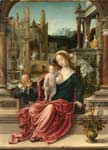
The Holy Family, Jan Gossaert

A Sloth, Joris Hoefnagel

Fly, Caterpillar, Pear, and Centipede, Joris Hoefnagel

Guide for Constructing the Letter E, Joris Hoefnagel

Guide for Constructing the Letters H and I, Joris Hoefnagel

Guide for Constructing the Letters f and g, Joris Hoefnagel

Maltese Cross, Mussel, and Ladybird, Joris Hoefnagel

Trompe-l'Oeil Stem of a Maltese Cross, Joris Hoefnagel

Still Life with Lemons, Oranges and a Pomegranate, Jacob van Hulsdonck
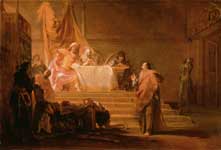
Solon before Croesus, Nikolaus Knuepfer

Mars and Venus, Allegory of Peace, Louis-Jean-Francois Lagrenee
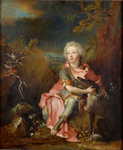
Portrait of a Boy in Fancy Dress, Nicolas de Largillière
 Brawl of Musicians, Georges de La Tour
Brawl of Musicians, Georges de La Tour

Madonna and Child with Two Donors, Lorenzo Lotto
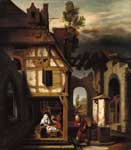
Adoration of the Shepherds, Nicolaes Maes

Saint Bernard's Vision of the Virgin and Child, Simon Marmion

Coronation of the Virgin with Saints Joseph and Francis of Assisi, Giulio Cesare Procaccini

Diana and Her Dog, Sebastiano Ricci

Landscape with the Temptation of Saint Anthony, Roelant Savery

Shepherd with a Flute, Giovanni Girolamo Savoldo
Fine Art Prints | Greeting Cards | Phone Cases | Lifestyle | Face Masks | Men's , Women' Apparel | Home Decor | jigsaw puzzles | Notebooks | Tapestries | ...
The J. Paul Getty Museum, commonly referred to as the Getty, is an art museum in California housed on two campuses: the Getty Center and Getty Villa.
The Getty Center is in the Brentwood neighborhood of Los Angeles and is the primary location of the museum. The collection features Western art from the Middle Ages to the present. Its estimated 1.3 million visitors annually make it one of the most visited museums in the United States.[2] The museum's second location, the Getty Villa, is in the Pacific Palisades neighborhood and displays art from ancient Greece, Rome, and Etruria.[3]History
In 1974, J. Paul Getty opened a museum in a re-creation of the Villa of the Papyri at Herculaneum on his property in Pacific Palisades, California.[4] In 1982, the museum became the richest in the world when it inherited US$1.2 billion.[5] In 1983, after an economic downturn in what was then West Germany, the Getty Museum acquired 144 illuminated medieval manuscripts from the financially struggling Ludwig Collection in Aachen; John Russell, writing in the New York Times, said of the collection, "One of the finest holdings of its kind ever assembled, it is quite certainly the most important that was in private hands."[6] In 1997, the museum moved to its current location in Brentwood; the Pacific Palisades museum, renamed the "Getty Villa", was closed for renovation until 2006.
GettyGuide
The Getty attracts approximately 1.8 million visitors a year.[7]
Detailed information about the J. Paul Getty Museum’s collections is provided on GettyGuide, a suite of interactive multimedia tools available at the Museum, as well as on getty.edu. At the GettyGuide stations in the Museum, visitors can get information about exhibitions, interact with a timeline, watch videos on art-making techniques, and more. Also available at the Museum, the GettyGuide multimedia player features commentary from curators and conservators on many works of art. With GettyGuide on the Web, one may browse the Museum’s collection[8] and bookmark works of art to create a customized tour and printable map.[9]
Architect Richard Meier chose beige-colored Italian travertine panels to cover the retaining walls and to serve as paving stones for the arrival plaza and Museum courtyard.[10]
The controversies with Italy and Greece
The Getty is involved in a controversy regarding proper title to some of the artwork in its collection. The museum's previous curator of antiquities, Marion True, was indicted in Italy in 2005 (along with famed dealer Robert E. Hecht) on criminal charges relating to trafficking in stolen antiquities. Similar charges have been addressed by the Greek authorities. The primary evidence in the case came from the 1995 raid of a Geneva, Switzerland, warehouse which had contained a fortune in stolen artifacts. Italian art dealer Giacomo Medici was arrested in 1997; his operation was thought to be "one of the largest and most sophisticated antiquities networks in the world, responsible for illegally digging up and spiriting away thousands of top-drawer pieces and passing them on to the most elite end of the international art market".[11] In 2005 True was forced to tender her resignation by the Board of Trustees, which announced her early retirement. Italy allowed the statute of limitations of the charges filed against her to expire in October 2010.[12]
In a letter to the J. Paul Getty Trust on December 18, 2006, True stated that she was being made to "carry the burden" for practices which were known, approved, and condoned by the Getty's Board of Directors.[13] True is currently under investigation by Greek authorities over the acquisition of a 2,500 year old funerary wreath. The wreath, along with a 6th-century BC statue of a woman, have been returned to Greece and are exhibited at the Archaeological Museum of Thessaloniki.[14]
On November 20, 2006, the director of the museum, Michael Brand, announced that 26 disputed pieces were to be returned to Italy, but not the Victorious Youth, which is still claimed by the Italian authorities. In 2007, the Los Angeles J. Paul Getty Museum was forced to return 40 artifacts, including a 5th-century BC statue of the goddess Aphrodite, which was looted from Morgantina, an ancient Greek settlement in Sicily.[15] The Getty Museum resisted the requests of the Italian government for nearly two decades, only to admit later that "there might be 'problems'" attached to the acquisition."[16] In 2006, Italian senior cultural official Giuseppe Proietti said: "The negotiations haven't made a single step forward." Only after he suggested the Italian government "to take cultural sanctions against the Getty, suspending all cultural cooperation,"[17] did the J. Paul Getty Museum return the antiquities.
In another unrelated case in 1999, the Getty Museum had to hand over three antiquities to Italy after determining they were stolen. The objects included a Greek red-figure kylix from the 5th-century BC, signed by the painter Onesimos and the potter Euphronios as potter, looted from the Etruscan site of Cerveteri; a torso of the god Mithra from the 2nd-century AD, and the head of a youth by the Greek sculptor Polykleitos.[18]
A Summary Catalogue of European Decorative Arts in the J. Paul Getty Museum was published in 2001. Indeed, some discrete works are provided with annotations, e.g. a picture frame from putatively the late 18th century with a modern mirror glass, which was bought at Sotheby's after the death of George Baillie-Hamilton, 12th Earl of Haddington, is equipped with the comment "possibly Paul Georges".[19]
See also
Getty Conservation Institute
Getty Foundation
Getty Research Institute
References
Top 100 Art Museum Attendance, The Art Newspaper, 2014. Retrieved on July 8, 2014.
"Forbes - Travel Information and Travel News - Forbes.com". Forbestraveler.com. Retrieved January 26, 2012.
"Visit the Getty". Getty.edu. Retrieved January 26, 2012.
"THE GETTY VILLA TO OPEN JANUARY 28, 2006". Press Release. J. Paul Getty Trust. Retrieved June 16, 2012.
McGill, Douglas C. (March 4, 1987). "Getty, The Art World's Big Spender". The New York Times. Retrieved May 5, 2010.
Eric Pace (July 23, 1996), Peter Ludwig, 71, German Art Collector, Dies New York Times.
"The J. Paul Getty Trust". The Getty. J. Paul Getty Museum. Retrieved May 19, 2015.
"Collection (Getty Museum)". J. Paul Getty Museum.
"Getty Bookmarks". J. Paul Getty Museum.
"The Getty Center - Architecture". The Getty. J. Paul Getty Museum. Retrieved May 21, 2015.
Men's Vogue, Nov/Dec 2006, Vol. 2, No. 3, pg. 46.
Felch, Jason and Ralph Frammolino (2011), Chasing Aphrodite: The Hunt for Looted Antiquities at the World's Richest Museum. Boston and New York: Houghton Mifflin Harcourt, pp. 265–66, 312.
Felch, Jason; Frammolino, Ralph (December 29, 2006). "Getty lets her take fall, ex-curator says". Los Angeles Times. Retrieved May 5, 2010.
"$1.5 mn Macedonian Gold Wreath Attracts Greek Populace". elitechoice.org. March 30, 2007.
Ariel, David (August 1, 2007). "Getty to Return Antiquities to Italy". Forbes.
Povoledo, Elisabetta (July 4, 2007). "In a Tug of War, Ancient Statue Is Symbol of Patrimony". The New York Times.
"Getty will return Aphrodite statue if it has origins in Italy". North County Times. November 22, 2006.
Slayman, Andrew (May–June 1999). "Getty Returns Italian Artifacts". Archaeology 52 (3).
Summary Catalogue of European Decorative Arts in the J. Paul Getty Museum, page 59, J. Paul Getty Museum, Gillian Wilson, Catherine Hess, Getty Publications, 2001. ISBN 9780892366323
----
Fine Art Prints | Greeting Cards | Phone Cases | Lifestyle | Face Masks | Men's , Women' Apparel | Home Decor | jigsaw puzzles | Notebooks | Tapestries | ...
----
Artist
A - B - C - D - E - F - G - H - I - J - K - L - M -
N - O - P - Q - R - S - T - U - V - W - X - Y - Z
Retrieved from "http://en.wikipedia.org/"
All text is available under the terms of the GNU Free Documentation License


